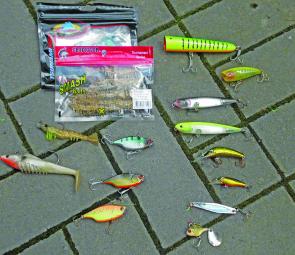Artificial lures are becoming more and more commonly used in fishing these days.
Fishing with lures can be very exciting, especially when a fish strikes your lure on the surface. Boredom is a common problem when fishing with baits, as a lot of the time there is a long wait between bites. However, when fishing with lures, you are constantly reeling in and casting back out, making it look alive!
Using lures also gives you the chance to learn about the behaviour of baitfish and predatory fish, including what kinds of fish will attack what kind of lure, and what colour is working best at that particular time.
There are many aspects and techniques to lure fishing, as you are trying to make something artificial look like a lively or injured baitfish, shrimp, squid, insects, or even small rodents. Anything that is prey for fish, there will be a lure for it! So before you start working out how to use lures, it’s a must that you know what kind of lures to use first.
There are many different styles of lures to learn about:
These lures float on the surface of the water and resemble injured or fast moving baitfish along the top of the water.
A lot of surface lures have a ‘cupped face’, they are known as poppers. They will make a popping sound on the surface of the water while splashing creating a bubble trail, they are dynamite on trevally!
Stickbaits are another sort of surface lure, when worked fast it will attract many pelagic (surface feeding) species.
A lot of surface lures have only whatever motion the angler applies; for example a walk-the-dog lure, when skilfully used, they can work a treat.
Spoon lures are very effective as they reflect off the light of the sun and cause a shimmer in the water, attracting any large fish around to hit it! They will flash in the light while wobbling or darting from side to side due to their shape and the fish cannot resist.
These lures work awesomely when on a boat, when cruising around looking for trevally in the estuaries or locating small tuna offshore. Cast these lures over the fish, and reel back fast through the ‘strike zone’.
These lures have a fish-like body shape with a bib on the front of the lure to cause it to move with a lifelike motion. Most are made to look exactly the same as different kinds of baitfish. They are all unique with their body shape and the bib creates different kinds of movements. The bib also comes in different sizes so the lure can dive to specific depths.
These lures are made with many different materials, to represent nearly all aquatic species that fish eat. They are generally matched with a specially made fly rod and reel, with fly line to help this unweighted lure cast out, flicked back, and retrieved. It takes a lot of experience to get these lures to work effectively.
Soft plastics are lures that are made of plastic or rubber. They are designed to resemble fish, squid, worms, crabs and even frogs. They will make predatory fish curious and want to attack it. And when they do, they will think it’s real due to the soft material.
Swimbaits are a form of soft plastic but are designed to resemble an actual swimming baitfish. It can be retrieved fast, slow or with a jigging motion. They have different kinds of tails including a paddle-tail, curl-tail, or split-tail. These are becoming more and more effective due to the way they are made, as they look more real each time. These lures can attract many fish to attack it.
Spinnerbaits are mostly pieces of special made wire at a certain angle, with the hook on the lower end and a spinner on the upper end. When moved through the water, the spinner will ‘spin’ round and round while flashing in the water, they look amazing and are fun to use. These lures are a personal favourite on the freshwater species, bass and yellowbelly (golden perch).
Now that you know what lures are out there, it’s key to know how to use them effectively. If you are able to get a few of these lures together have a practice at different jigging motions, especially with soft plastics. A good style to use when fishing with soft plastics, spinners, minnows or swimbaits is to cast out, wait until it hits the bottom (when you see the line go slack), then give it a couple of flicks with your rod, and keep repeating this until you have got the lure back to you, then do it again. When the fishing is good and the lures are used correctly, it should take no time until you get a fish.
Fishing lures is great fun, especially for junior anglers. Instead of sitting there waiting for a bite, you can be using your lures, casting and retrieving all day while fishing. So next time you have the chance to fish, have a go with lures, it’s great fun and will teach you many different aspects and techniques, while you’re fishing!
Reads: 4039
Here is an assortment of lures that work great whenever or wherever you go fishing.




